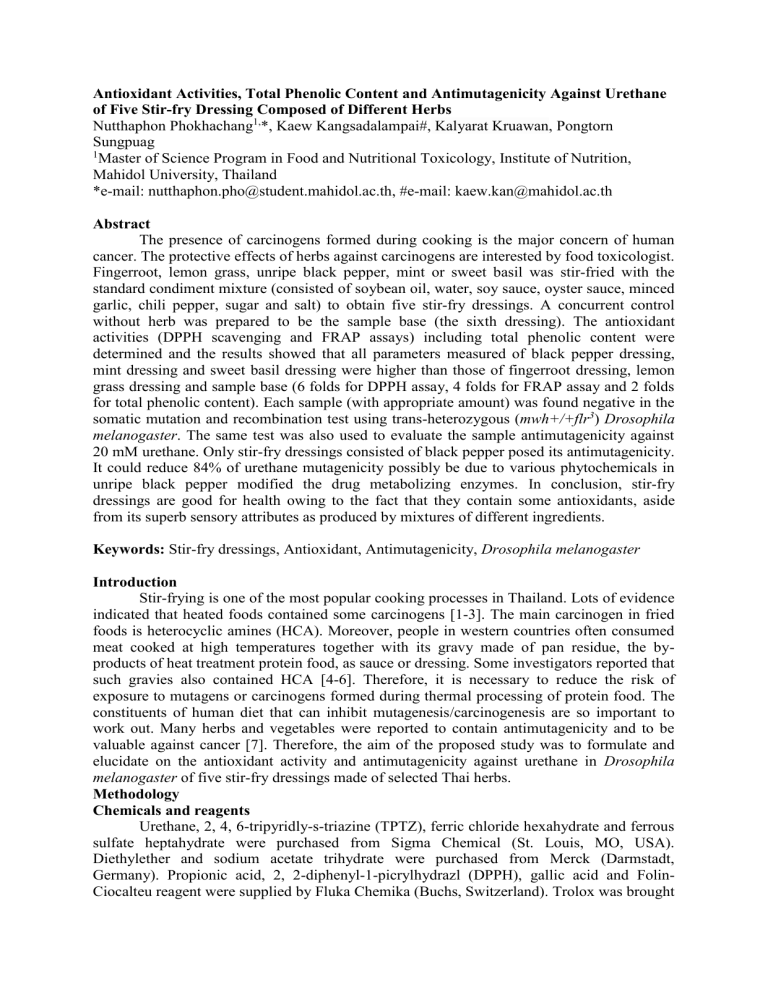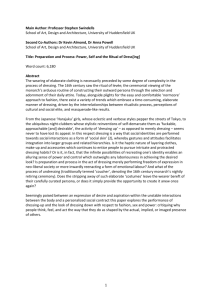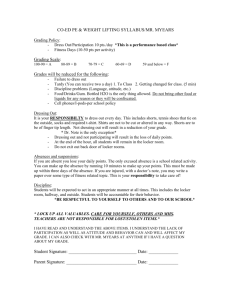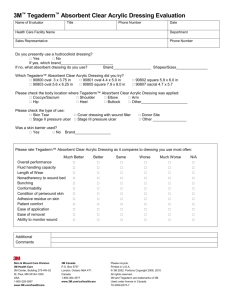Antimutagenicity Against Urethane, Antioxidant Activities And Total

Antioxidant Activities, Total Phenolic Content and Antimutagenicity Against Urethane of Five Stir-fry Dressing Composed of Different Herbs
Nutthaphon Phokhachang 1, *, Kaew Kangsadalampai#, Kalyarat Kruawan, Pongtorn
Sungpuag
1
Master of Science Program in Food and Nutritional Toxicology, Institute of Nutrition,
Mahidol University, Thailand
*e-mail: nutthaphon.pho@student.mahidol.ac.th, #e-mail: kaew.kan@mahidol.ac.th
Abstract
The presence of carcinogens formed during cooking is the major concern of human cancer. The protective effects of herbs against carcinogens are interested by food toxicologist.
Fingerroot, lemon grass, unripe black pepper, mint or sweet basil was stir-fried with the standard condiment mixture (consisted of soybean oil, water, soy sauce, oyster sauce, minced garlic, chili pepper, sugar and salt) to obtain five stir-fry dressings. A concurrent control without herb was prepared to be the sample base (the sixth dressing). The antioxidant activities (DPPH scavenging and FRAP assays) including total phenolic content were determined and the results showed that all parameters measured of black pepper dressing, mint dressing and sweet basil dressing were higher than those of fingerroot dressing, lemon grass dressing and sample base (6 folds for DPPH assay, 4 folds for FRAP assay and 2 folds for total phenolic content). Each sample (with appropriate amount) was found negative in the somatic mutation and recombination test using trans-heterozygous ( mwh+/+flr
3
) Drosophila melanogaster . The same test was also used to evaluate the sample antimutagenicity against
20 mM urethane. Only stir-fry dressings consisted of black pepper posed its antimutagenicity.
It could reduce 84% of urethane mutagenicity possibly be due to various phytochemicals in unripe black pepper modified the drug metabolizing enzymes. In conclusion, stir-fry dressings are good for health owing to the fact that they contain some antioxidants, aside from its superb sensory attributes as produced by mixtures of different ingredients.
Keywords: Stir-fry dressings, Antioxidant, Antimutagenicity, Drosophila melanogaster
Introduction
Stir-frying is one of the most popular cooking processes in Thailand. Lots of evidence indicated that heated foods contained some carcinogens [1-3]. The main carcinogen in fried foods is heterocyclic amines (HCA). Moreover, people in western countries often consumed meat cooked at high temperatures together with its gravy made of pan residue, the byproducts of heat treatment protein food, as sauce or dressing. Some investigators reported that such gravies also contained HCA [4-6]. Therefore, it is necessary to reduce the risk of exposure to mutagens or carcinogens formed during thermal processing of protein food. The constituents of human diet that can inhibit mutagenesis/carcinogenesis are so important to work out. Many herbs and vegetables were reported to contain antimutagenicity and to be valuable against cancer [7]. Therefore, the aim of the proposed study was to formulate and elucidate on the antioxidant activity and antimutagenicity against urethane in Drosophila melanogaster of five stir-fry dressings made of selected Thai herbs.
Methodology
Chemicals and reagents
Urethane, 2, 4, 6-tripyridly-s-triazine (TPTZ), ferric chloride hexahydrate and ferrous sulfate heptahydrate were purchased from Sigma Chemical (St. Louis, MO, USA).
Diethylether and sodium acetate trihydrate were purchased from Merck (Darmstadt,
Germany). Propionic acid, 2, 2-diphenyl-1-picrylhydrazl (DPPH), gallic acid and Folin-
Ciocalteu reagent were supplied by Fluka Chemika (Buchs, Switzerland). Trolox was brought
from Aldrich Chemical (Milwaudee, WI, Germany). All other chemicals and reagents were of analytical grade.
Stir-fry Dressings Preparation
The standard condiment mixture consisted of soybean oil (20 ml), water (100 ml), soy sauce (15 ml), oyster sauce (15 ml), minced garlic (10 g), chili pepper (10 g), sugar (3 g) and salt (1 g) were prepared. It was mixed with a certain herb (20 g), namely fingerroot, lemon grass, black pepper (unripe), mint or sweet basil; the mixture was stir-fried for 90 seconds to obtain five dressings. A concurrent control without herb was also prepared to be the sample base or the sixth dressing. Each finished dressing was homogenized and lyophilized for further study.
Antioxidant Activities and Total Phenolic Content
A portion of sample (1 g) was extracted for 1 h with 80% ethanol (10 ml) at 40ºC on an orbital shaker set at 120 rpm. Then, the extract was filtered through Whatman filter paper
No.1 and was collected into a glass bottle. Each ethanolic extract was assayed for DPPH free radical scavenging activity [8], ferric reducing antioxidant power or FRAP [9] and the total phenolic content [10] as suggested by Kruawan and Kangsadalampai [11].
Somatic Mutation and Recombination Test
In the mutagenicity testing, each freeze-dried sample was mixed with the dry components of standard Drosophila medium [12] to obtain the final 6.25, 12.5, 25 or 50% w/w of sample in the medium; then, the mixture was added with water and proceeded to be the experimental medium. Urethane (20 mM) was substituted for water in the experimental medium in order to evaluate the antimutagenicity of each sample. The standard medium containing 20 mM urethane was used as the positive control. The test was performed as described by Graf et al [13].
Virgin females of Oregon wing flare strain ( ORR/ORR;flr3/TM3 ,
Ser) were mated with males of multiple wing hair strain ( mwh/mwh ) on standard medium to produce trans-heterozygous larvae of improved high bioactivation cross; both strains were kindly provided by Professor U. Graf (University of Zurich, Switzerland). One hundred larvae were transferred to each experimental medium and maintained at 25+1 o
C until pupation. The surviving adult flies bearing the marker trans-heterozygous ( mwh flr+/mwh
TM3 ) indicated with round wings were collected. Wings were removed and mounted on a glass slide. Toxicity of each sample was determined from the data of survival rate of adult flies. The wing spots data were evaluated using the statistical procedure and a multiple decision procedure as described by Frei and Wurgler [14].
The antimutagenicity of each sample was determined from the percentage of inhibition calculated accordingly to the following equation:
Percentage of inhibition = (( a-b)/a ) 100
When a is the frequency of spots induced by urethane alone and b is the frequency of spots induced by urethane in the presence of sample. It is proposed that percentages of inhibition between 0-20 represent a negligible effect while expression of percent inhibitions between 20-40, 40-60 and more than 60 are the evidences of weak, moderate and strong antimutagenicity, respectively as suggested by Abraham [15].
Results
The antioxidant activities of each stir-fry dressing are shown in Figure 1. The capacity
(µM TEAC/g dry weight) is shown in Figure 1A. Free radical scavenging activity of reducing of DPPH by antioxidant of each sample expressed as Trolox equivalent antioxidant each sample ranged from 0.8187 to 19.7702 TEAC/g dry weight. The FRAP value (µM/g dry weight) of each sample ranged from 5.2241 to 42.9463 µM/g dry weight (Figure 1B). The total phenolic content (mM gallic acid/g dry weight) of each sample ranged from 1.5773 to
4.2347 mM gallic acid/g dry weight (Figure 1C). The results revealed that all parameters
Figure 1.
Antioxidant activity in DPPH assay (A), antioxidant activity in FRAP assay (B) and total phenolic content (C) of ethanol extracts from each stir-fry dressing .
measured of black pepper dressing, mint dressing and sweet basil dressing were higher than those of fingerroot dressing, lemon grass dressing and sample base (6 folds for DPPH assay,
4 folds for FRAP assay and 2 folds for total phenolic content).
In the mutagenicity evaluation, the number of induced wing spots of adult flies derived from larvae brought up on Drosophila medium containing each sample (at 6.25% for black pepper dressing, 12.5% for mint dressing, sweet basil dressing, fingerroot dressing, lemon grass dressing and sample base) was not different from that of the flies brought up on the negative control medium (data not shown). This indicated that most samples contain none or undetectable mutagens. The number of wing spots of adult flies obtained from Drosophila medium containing both sample and urethane was compared with that of adult flies obtained from positive control group in order to derive the percentage of mutagenicity inhibition. Only the medium containing 6.25% black pepper dressing reduced the mutagenicity of urethane, up to 83.742%, while others did not (Figure 2).
Figure 2 . The modulating effect of each stir-fry dressing against urethane (20 mM) induced somatic mutation and recombination in Drosophila melanogaster derived from trans-heterozygous ( mwh+/+flr 3 ) larvae.
Discussion and conclusion
The results of this study revealed that stir-fry dressings were good sources of antioxidants including phenolic compounds. This may be due to the fact that all dressings contained herbs and spices, namely chili pepper ( Capsicum frutescens ) and garlic ( Allium sativum ) as that are the sources of antioxidants [16, 17]. Garlic has polyphenolic and sulphur containing compounds such as alliin, allyl cysteine, allyl disulfide and allicin, which are responsible for its antioxidant activity [18]. Chili pepper contains many important antioxidants, such as ascorbic acid, capsaicin and phenolic compounds [19]. Therefore, It was not surprised that why the sample base (contained no herb) had the lowest in both antioxidant activities and total phenolic content because each herb contained different antioxidative phytochemicals.
The results revealed the safeness of most samples for consumers. None of the samples was mutagenic since they did not significantly induce the frequencies of mutant spots to be higher than that of the negative control group. The survival rates of adult flies obtained from larvae fed on medium containing each sample were not much different from those of the
negative control group. It must be noted that the high content of unsaturated fatty acids in soy bean oil used in the preparation of stir-fry dressing might contribute to certain level of free radicals that may be toxic to Drosophila melanogaster larvae. This tester organism generally lacks of superoxide dismutase [20, 21]; this was why the amount of some samples added in the experimental medium was to reduce to 6.25%, 12.5% or 25% depending on the surviving rate of flies.
Overall results of the present investigation showed that only black pepper dressing could reduce the mutagenicity of urethane. The high bioactivation Drosophila melanogaster strain used in the present study is highly sensitive to the genotoxic effects of urethane because of its high constitutive level of cytochrome P-450 activity [22, 23]. Hence, it represents an extreme state of genetic susceptibility to urethane. The pathway of activation of urethane is thought to involve two steps, both catalyzed by the cytochrome P-450 CYP 2E1; these steps are desaturation or urethane to vinyl carbamate, followed by oxidation to vinyl carbamate epoxide [24]. Therefore, the modulating effect of the dressing could be the result of more than one mechanism from all ingredients in the dressing. The modulation detoxifying system could be a mechanism to inhibit the mutagenicity of urethane. It is postulated that the sample might act as an inducer of glutathioneS -transferase (GST) or an inhibitor of cytochrome P-450 system. Black pepper contains flavonoids that effectively counteracted the mutagenicity of urethane in the somatic and recombination test [25].
In conclusion, stir-fry dressings are good for health owing to the fact that they contain some antioxidants, aside from its superb sensory attributes as produced by mixtures of different ingredients. However, the study on their antimutagenicity against urethane in
Drosophila melanogaster was satisfied only for black pepper dressing. Further experiments should be extended to other animals for the sake that other dressings might express their antimutagenicity against some other mutagens.
References
1.
Fretheim K. Polycyclic aromatic hydrocarbons in grilled meat products—A review. Food Chem. 1983;
10:129-39.
2.
Kazerouni N, Sinha R, Hsu CH, Greenberg A, Rothman N. Analysis of 200 food items for benzo[a]pyrene and estimation of its intake in an epidemiologic study. Food Chem Toxicol. 2001; 39:423-36.
3.
Pais P, Knize MG. Chromatographic and related techniques for the determination of aromatic heterocyclic amines in foods. J Chromatogr B Biomed Sci Appl. 2000; 747:139-69.
4.
Janoszka B, Błaszczyk U, Damasiewicz-Bodzek A, Sajewicz M. Analysis of heterocyclic amines (HAs) in pan-fried pork meat and its gravy by liquid chromatography with diode array detection. Food Chem. 2009;
113:1188-96.
5.
Janoszka B. Heterocyclic amines and azaarenes in pan-fried meat and its gravy fried without additives and in the presence of onion and garlic. Food Chem. 2010; 120:463-73.
6.
Sinha R, Rothman N, Salmon CP, Knize MG, Brown ED, Swanson CA, et al . Heterocyclic amine content in beef cooked by different methods to varying degrees of doneness and gravy made from meat drippings.
Food Chem Toxicol. 1998; 36:279-87.
7.
Kusamran WR, Tepsuwan A, Kupradinun P. Antimutagenic and anticarcinogenic potentials of some Thai vegetables. Mutat Res/Fundamental and Molecular Mechanisms of Mutagenesis. 1998; 402:247-58.
8.
Fukumoto LR, Mazza G. Assessing antioxidant and pro-oxidant activities of phenolic compounds. J Agric
Food Chem. 2002; 48:3597-604.
9.
Benzie IFF, Strain JJ. The ferric reducing ability of plasma as a measure of “antioxidant power” the FRAP assay. Anal Biochem. 1996; 239:70-6.
10.
Faller ALK, Fialho E. Polyphenol content and antioxidant capacity in organic and conventional plants food. J Food Comp Anal. 2010; 23:561-8.
11.
Kruawan K and Kangsadalampai K. Antioxidant activity, phenolic compound contents and antimutagenic activity of some water extract of herbs. Thai J Pharm Sci. 2006; 30:28-35.
12.
Roberts DB. Basic Drosophila care and techniques. In: Roberts DB, editor. Drosophila: a pratical approach. Oxford: IRL Press; 1986:1-38.
13.
Graf U, Würgler FE, Katz AI, Frei H, Juon H, Hall CB. Somatic mutation and recombination test in
Drosophila melanogaster. Environ Muta. 1984; 6:153-88.
14.
Frei H, Wurgler FE. Statistical methods to decide whether mutagenicity test data from Drosophila assay indicate a positive, negative or inconclusive result. Mutat Res. 1988; 203:297-308.
15.
Abraham SK. Antigenotoxicity of coffee in the Drosophila assay for somatic mutation and recombination.
Mutagenesis. 1994; 9:383-6.
16.
Madsen HL, Bertelsen G. Spices as antioxidants. Trends Food Sci Tech. 1995; 6:271-7.
17.
Zheng W, Wang S. Antioxidant activity and phenolic composition in selected herbs. J Agric Food Chem.
2001; 49:5165-70.
18.
Chung LY. The antioxidant properties of garlic compounds: allyl cysteine, alliin, allicin, and allyl disulfide. J Med Food. 2006; 9(2):205-13.
19.
Antonious GF, Kochhar TS, Jarret RL, Snyder JC. Antioxidants in hot pepper: variation among accessions.
J Environ Sci Health., B: Pesticides, Food Contaminants, and Agricultural Wastes. 2006; 41:1237-43.
20.
Rogina B, Helfand SL. Cu, Zn superoxide dismutase deficiency accelerates the time course of an agerelated marker in Drosophila melanogaster. Biogerontology.
2000; 1:163-9.
21.
Missirlis F, Phillips JP, Jackle H. Cooperative action of antioxidant defense systems in Drosophila. Curr
Biol. 2001; 11:1272-7.
22.
Graf U, van Schaik N. Improved high bioactivation cross for the wing somatic mutation and recombination test in Drosophila melanogaster. Mutat Res. 1992; 271:59–67.
23.
Frolich A, Wurgler FE. Genotoxicity of ethyl carbamate in the Drosophila wing-spot test: dependence on genotype-controlled metabolic capacity. Mutat Res. 1990; 244:201–208.
24.
Guengerich F, Kim D, Iwasaki M. Role of human P-450IIE1 in the oxidation of many low molecular weight cancer suspects. Chem Res Toxicol. 1991; 4:168–179.
25.
Hamss RE, Idaomar M, Moraga AA, et al . Antimutagenic properties of bell and black pepper. Food Chem
Toxicol. 2003; 41:41-7.








